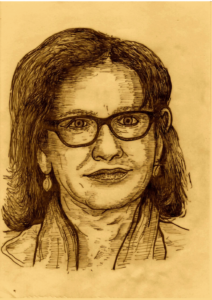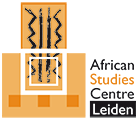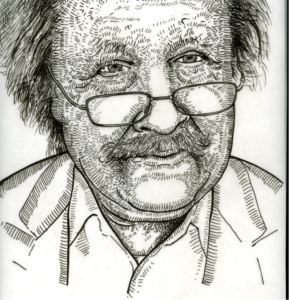
Noam Chomsky ~ Photo: en.wikipedia.org
Just how bad are things with Donald Trump in the White House? And what does having a racist, misogynist, xenophobic and erratic president who continues to enjoy unquestionable support from his base tell us about the state of US politics and the dangers to the future of democracy in the US and in the world on the whole? Noam Chomsky shares his thoughts on these and other related questions in an exclusive interview with C. J. Polychroniou for Truthout.
C.J. Polychroniou: Noam, it’s been already 14 months into Donald Trump’s turbulent White House tenure, but sometimes we still need to pinch ourselves to make sure that it’s not a nightmare that a racist, misogynist, homophobic man who apparently cares only about himself runs the world’s most powerful nation. But, really, how bad is it having Trump in the White House?
Very bad. As Trump began his second year in office, the Bulletin of Atomic Scientists advanced their Doomsday Clock to two minutes to midnight, citing increasing concerns over nuclear weapons and climate change. That’s the closest it has been to terminal disaster since 1953, when the US and USSR exploded thermonuclear weapons. That was before the release of Trump’s Nuclear Posture Review, which significantly increases the dangers by lowering the threshold for nuclear attack and by developing new weapons that increase the danger of terminal war.
On climate change, Trump is a complete disaster, along with the entire Republican leadership. Every candidate in the Republican primaries either denied that what is happening is happening or said … we shouldn’t do anything about it. And these attitudes infect the Republican base. Half of Republicans deny that global warming is taking place, while 70 percent say that whether it is or not, humans are not responsible. Such figures would be shocking anywhere, but are remarkably so in a developed country with unparalleled resources and easy access to information.
It is hard to find words to describe the fact that the most powerful country in world history is not only withdrawing from global efforts to address a truly existential threat, but is also dedicating itself to accelerating the race to disaster, all to put more dollars in overstuffed pockets. No less astounding is the limited attention paid to the phenomenon.
When we turn to matters of great though lesser import, the conclusion is the same: disaster. While Trump’s antics occupy the attention of the media, his associates in Congress have been working intensively to advance the interests of their actual constituency — extreme wealth and corporate power — while dismantling what is of value to the general population and future generations. With justice, the Republican leadership regard the tax bill as their greatest triumph. Joseph Stiglitz rightly describes the triumph as “The US Donor Relief Act of 2017,” a vast giveaway to their actual constituency — and to themselves. As he points out, the Republican leaders “are stuffing themselves at the trough — Trump, Kushner and many others in his administration are among the biggest winners — thinking that this may be their last chance at such a feast.” And “Après moi, le deluge” — literally in this case.
The grand triumph brings an extra advantage. It explodes the deficit (a trademark of Republicans since Reagan), which means that they can move on to cut away at entitlements, as the chief architect, Paul Ryan, announced happily at once. The US already ranks near the bottom of the [Organization for Economic Cooperation and Development] countries — the 35 richer and more developed countries — in social justice measures. The Republican triumph will sink it even lower. The tax scam is only the most prominent of the devices being implemented under the cover of Trump buffoonery to serve wealth and corporate power while harming the irrelevant population.
Many other policies are simply [unconscionable], such as Trump’s initiative to have the Department of Homeland Security separate children, even infants, from their mothers in order to discourage immigration — 700 families have been split in this fashion since October, a New York Times investigation found. Many of these families are fleeing from the murderous consequences of US policies: Honduras has been the main source of refugee flight since the US, almost alone, endorsed the military coup that ousted the elected president and the fraudulent election that followed, initiating a reign of terror.
We also must endure the sight of Trump wailing in terror because a caravan of victims reached Mexico, most hoping to settle there. Trump’s suggestion that these victims are threatening the security of the US is reminiscent of Reagan strapping on his cowboy boots and calling a national emergency because Nicaraguan troops were a two days march from Texas, and about to overwhelm us. It’s amazing that such performances do not evoke profound national embarrassment.
To the extent that politics is the art of the possible, would you say that Trump has been consistent so far with the promises he made to voters during the 2016 campaign?
In some cases, yes. He is fulfilling the wishes of the Evangelicals who are a large part of his voting base. He is greatly increasing the military budget, as he promised. … Most of his promises are about as close to fulfillment as his commitment to “drain the swamp,” which is now overflowing. [Scott] Pruitt’s [Environmental Protection Agency] alone is a cesspool, though its dismantling of efforts to deal with the impact of climate change are far more serious than the wholesale robbery, which seems to be a Pruitt specialty from well before he was handed the wrecking ball.
On trade, though the policies, insofar as they are coherent, are generally harmful, the rhetoric is not completely false. Thus it is true that China is using devices that violate World Trade Organization rules — devices that were critical to the growth of the rich societies, from England to the US and beyond, and are now banned by the investor rights agreements mislabeled “free trade agreements.” This is a textbook illustration of what economic historians call “kicking away the ladder”: First we climb up, then we kick the ladder away so that you can’t follow.
And Trump is right that the [North American Free Trade Agreement (NAFTA)] should be revised. Some sensible proposals have been put forth by the partners in NAFTA. For example, Canada has proposed that the revised NAFTA should ban harsh US anti-labor laws, like the right-to-scrounge laws called “right-to-work” in contemporary Newspeak. These laws are soon to become federal policy, it seems, under the reactionary Roberts Court, which was made more extreme by [Senate Majority Leader Mitch] McConnell’s shameful parliamentary maneuvers to prevent even consideration of Obama’s nomination, opening the way to the appointment of Neil Gorsuch — another gift to the far right.
The Canadian proposal was prominently reported in the major Canadian press, but, oddly, is missing from the discussions of NAFTA revision here, which keep to Trump proposals.
Allegations of collusion continue to haunt Donald Trump’s presidency, primarily over his alleged ties to Russia and Putin, and former FBI Director James Comey said in a recent interview with ABC News that Trump is “morally unfit” to be president. What’s your take on all this, and what does Trump’s disrespect for law and the fact that his base is refusing to abandon him tell us about the current state of American democracy and US politics in general?
We don’t need Comey to tell us that Trump is morally unfit. He made that abundantly clear in the primaries, if not before. The fact that the Oval Office is coming to resemble a schoolyard on a bad day may be obnoxious, but it doesn’t rank high among the misdeeds of the administration, in my opinion. … Same with his alleged ties to Russia and Putin. Much more serious is the clique that now surrounds him. It’s a sad day when one has to hope that General [James] Mattis will keep the … [rest] in check. The [John] Bolton appointment in particular should send shivers up the spine of any person.
As for Trump’s base, they are indeed quite loyal. Most Trump voters were relatively affluent and probably are fairly satisfied with the ultra-reactionary policies. Another important segment was non-college-educated whites, a group that voted overwhelmingly for Trump (a 40 percent advantage). There is a close analysis of this group in the current (Spring 2018) issue of the Political Science Quarterly. It found that racism and sexism were far more significant factors in their vote than economic issues. If so, this group has little reason to object to the scene that is unfolding, and the same with the white Evangelicals who gave Trump 80 percent of their vote. Among justly angry, white, working-class Trump voters, many apparently enjoy watching him stick his thumb in the eyes of the hated elites even if he doesn’t fufill his promises to [working-class voters], which many never believed in the first place.
What all this tells us, yet again, is that the neoliberal programs that have concentrated wealth in a few hands while the majority stagnate or decline have also severely undermined functioning democracy by familiar mechanisms, leading to anger, contempt for the dominant centrist political forces and institutions, and often anti-social attitudes and behavior — alongside of very promising popular reactions, like the remarkable [Bernie] Sanders phenomenon, [Jeremy] Corbyn in England and positive developments elsewhere as well.
Ryan, an influential architect of the Republican economic platform, announced that he is stepping down from Congress. Do you think his decision was motivated by the fear that a “blue wave” may be coming in November as a result of a growing backlash against Trump and Trumpism?
There is much talk about how this “admirable” figure, who bedazzled the media with fraudulent spreadsheets, wants to spend time with his family. Much more likely, I think, is that he decided to leave Congress because he had achieved his long-standing goals, particularly with the “Donor Relief Act of 2017” and the deficit cuts that open the way to sharp reduction of entitlements: health, social security, pensions — whatever matters to the people beyond the very privileged. And perhaps he prefers to be out of town when it becomes too hard to conceal what’s being done to the general population and someone will have to face the music.
With regard to foreign affairs, what do you consider to be the most menacing elements of Trump’s handling of US foreign policy?
Trump inherited multiple crises. His own policies have been largely incoherent, but he has been consistent in some areas, primarily the Middle East. He has provided strong support for the Saudi war in Yemen, a major catastrophe, and is exulting in the huge arms sales to the dictatorship. Last December, UN agencies warned that the Saudi blockade of Yemen could lead to “one of the largest famines in modern times.” Yemen already has the world’s worst cholera outbreak, which is not under control. The Saudi blockade is hindering desperately needed imports of food, medicine and fuel.
Apart from the human disaster it is creating, the Saudi dictatorship, always with firm US backing, seems intent on carrying forward the Taliban and ISIS projects of destroying precious antiquities. Reviewing the systematic Saudi destruction, the chair of Yemen’s Organization of Antiquities and Museums charges that the attacks on 60 sites are “a conscious campaign to wreck Yemen’s heritage and demoralize its citizens.” Western experts agree that the destruction seems deliberate, using information provided by the [United Nations Educational, Scientific and Cultural Organization] on cultural heritage sites to direct bombing attacks, with no military objective.
The US-led attack on ISIS in Raqqa destroyed the city, and nothing is being done to reconstruct or help the victims. Under the influence of [US-UN Ambassador] Nikki Haley, one of the more sinister (and, it seems, ambitious) figures in the administration, Trump has sharply cut funding to the [United Nations Relief and Works Agency], which barely keeps millions of Palestinian refugees alive. In general, “make America great” means great at destroying, and that’s where the greatness ends. It’s by no means entirely new, but is now raised to a higher level and becoming a matter of principle.
In May, Trump will presumably refuse to renew sanctions relief for Iran, as required by the Iran nuclear deal (JCPOA). That does not constitute formal withdrawal, though that’s the likely effect. Even if the European signers formally persist, the consequences will be severe because of the central role of the US in the international financial system — not to speak of the danger that their persistence might arouse the ire of the unpredictable Trump, who can do a great deal of damage if crossed. Effective withdrawal might provide an opening for the new national security adviser, Bolton, a genuine war criminal who publicly calls for bombing Iran, presumably in collaboration with Israel and with tacit Saudi approval. Consequences could be horrendous.
There is much fevered debate as to whether Iran might have violated the JCPOA, contrary to the firm conclusion of [the International Atomic Energy Agency] Director General Yukiya Amano on March 5, 2018, that “Iran is implementing its nuclear-related commitments.” But we hear virtually nothing about US violations, though these have been clear enough. Thus the JCPOA commits the signers to support the successful implementation of the agreement, including in their public statements, and to refrain from any adverse effect on trade and economic relations with Iran that conflict with their commitments to successful implementation of the JCPOA. The US has been in flat violation of all of these commitments, which have serious consequences.
Unmentionable as always is the obvious way to alleviate whatever threat Iranian nuclear programs are imagined to pose: establishing a nuclear weapons-free zone in the region. The way is clear. The proposal is strongly supported by Iran, the Arab states and the world generally. But there is an impediment. It has regularly been blocked by the US, for familiar reasons: Israel’s nuclear weapons. Also ignored is that the US [and] UK have a special commitment to work for this goal, having committed themselves to it in the UN [Security Council] resolution they invoked in an effort to find some thread of justification for their invasion of Iraq.
There is more to say about this troubled region, but there are crises elsewhere as well. One involves North Korea, and here there might be some rays of light. Trump has so far accepted the moves of the two Koreas toward improving relations, and has agreed to negotiations with North Korean dictator Kim Jong Un that so far look promising. If these initiatives succeed, they might go as far as the September 2005 agreement in which North Korea pledged to abandon “all nuclear weapons and existing weapons programs.” Unfortunately, the Bush administration immediately violated all of its commitments under the agreement, and North Korea proceeded with its nuclear weapons programs. We may hope that Trump will be willing to accept success in denuclearizing the peninsula and in further steps toward accommodation. And if he wants to brag about the achievement as a demonstration of his brilliance as a deal-maker, just fine.
This by no means exhausts the foreign policy issues that should be seriously addressed — topics that would carry us far afield.
What’s your overall sense about Trumpism? What is it really all about, and do you think Trumpism is showing us the future of right-wing politics in the US?
Trumpism is one of many manifestations of the effects of the neoliberal policies of the past generation. These have led to extreme concentration of wealth along with stagnation for the majority. There have been repeated crashes of the deregulated financial institutions, each worse than the last. Bursting bubbles have been followed by huge public bailouts for the perpetrators while the victims have been abandoned. Globalization has been designed to set working people throughout the world in competition with one another while private capital is lavished with benefits. Democratic institutions have eroded. As already mentioned, all of this has led to anger, bitterness, often desperation — one remarkable effect is the increasing mortality among middle-age whites discovered by Anne Case and Angus Deaton, analyzed as “deaths of despair,” a phenomenon unknown in functioning societies. While there are variations from place to place, some features are common. One is the decline of the centrist parties that have long dominated political life, as we see in election after election. In the US, in recent years, whenever candidates arose from the base in the Republican primaries, the established powers were able to crush them and impose their own choice: Mitt Romney, most recently. In 2016, for the first time they were unable to do so, but they quickly rallied to the winning candidate, who proved quite willing to front for the more brutal wing of the traditional party. The real surprise in the election was the Sanders campaign, which broke with a long tradition of pretty much bought elections, and was stopped only by machinations of the Obama-Clinton party managers. The Democratic Party is now split between the donor-oriented New Democrat managers and a growing activist social democratic base.
What all of this portends, worldwide, is far from clear. Though there are also significant signs of hope, some commentators have — with good reason — been quoting Gramsci’s observation from his prison cell: “The crisis consists precisely in the fact that the old is dying and the new cannot be born; in this interregnum a great variety of morbid symptoms appear.”
Copyright, Truthout. May not be reprinted without permission.
 De wereld van na 1989 is gevormd door een grote hoeveelheid filosofische vooronderstellingen, aldus Neiman. Het neoliberalisme suggereert dat er geen andere waarden bestaan dan marktwaarden, hetgeen bekrachtigt wordt door de evolutiebiologie met de onbewijsbare wetenschappelijke theorieën: wij zijn biologisch geprogrammeerd om zoveel mogelijk exemplaren van onszelf voort te brengen. Deze beide ideologieën gaan ervan uit dat aanspraken op waarheid aanspraken op macht zijn. Ze zijn zo binnen gedrongen in de publieke opinie, dat we ze niet meer als zodanig herkennen.
De wereld van na 1989 is gevormd door een grote hoeveelheid filosofische vooronderstellingen, aldus Neiman. Het neoliberalisme suggereert dat er geen andere waarden bestaan dan marktwaarden, hetgeen bekrachtigt wordt door de evolutiebiologie met de onbewijsbare wetenschappelijke theorieën: wij zijn biologisch geprogrammeerd om zoveel mogelijk exemplaren van onszelf voort te brengen. Deze beide ideologieën gaan ervan uit dat aanspraken op waarheid aanspraken op macht zijn. Ze zijn zo binnen gedrongen in de publieke opinie, dat we ze niet meer als zodanig herkennen.




